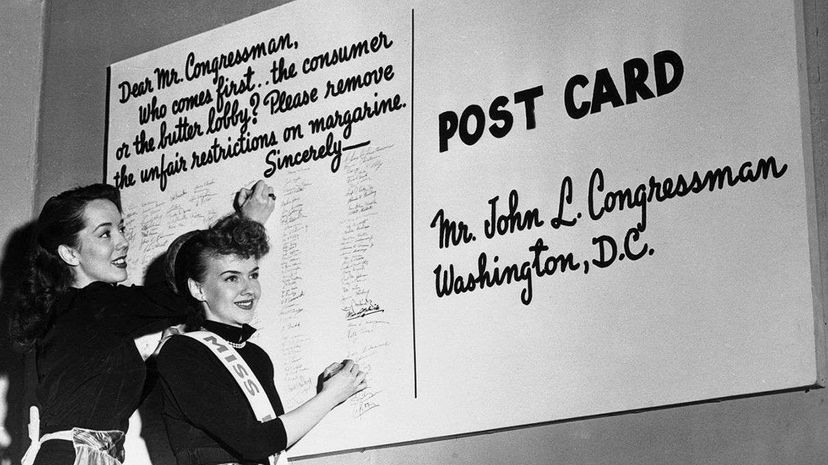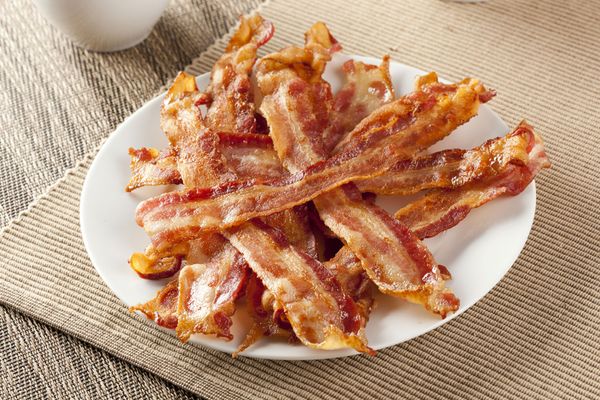
Butter substitutes have a rich history, but lest we spread ourselves too thin, we'll concentrate on the particularly curious period between the 1880s and 1950s, when margarine was outlawed in Canada and margarine-hungry Canadians bootlegged the stuff.
Newfoundland manufactured margarine because it made good sense. Its climate was too cold to reliably source cream from cows, and margarine could be made with a combination of vegetable, mineral and animal oils (most notably seal oil). This made margarine remarkably cheaper to produce than butter. Those cost savings trickled down to the consumer, making margarine available to every strata of society.
Advertisement
Newfoundland's margarine manufacturers were committed to keeping their customers loyal, and that meant keeping them incentivized to eat it. In 1931, when nutritional study findings revealed that Newfoundlanders were deficient in vitamins A and D, margarine manufacturers added those ingredients to their product. (This isn't as nefarious as it sounds; additives make it into food products all the time. Look for labels that say “fortified with” to get an idea of which foods in your pantry are pumped up with vitamins.)
Everyone could afford margarine. Everyone got a little more vitamins A and D when they ate it. Plus, the booming margarine business kept people in the workforce. What could go wrong?
At the time, Newfoundland was still a British colony. In 1949, it became part of Canada — where dairy farmers were fiercely protective of their trade. In fact, margarine had been outlawed in Canada since 1886. Canada's Parliament passed federal legislation in 1949 to prohibit the manufacture and sale of margarine anywhere in Canada, except Newfoundland and Labrador, where it had an industrial stronghold. But that didn't stop margarine-hungry Canadians from bringing it across the border. By 1950, the law was revised so that margarine manufacturing, importing and exporting would be regulated on the provincial level. Until 2008, Quebec regulated that margarine had to be sold colorless so it wouldn't be confused with yellow butter.
O, Canada, right? Hold your harrumphs. Americans were equally as mad about margarine. Just as your great-grandmother would turn up her nose at any number of shelf-stable foods in your pantry today, Americans in the late 1800s were incredibly suspicious of food substitutes. In Nina Teicholz's “The Big Fat Surprise,” a book that examines the benefits of consuming animal fats over vegetable fats, she quotes Minnesota Gov. Lucius Frederick Hubbard, who in 1880 called margarine “‘a mechanical mixture' created by ‘the ingenuity of depraved human genius.'” Previous food substitutes — like Crisco, which replaced animal lard — were intended for cooking and couldn't be seen in the foods gracing dinner tables. Margarine, on the other hand, was intended to be eaten in its original form.
From 1917 to 1928, plenty of bills proposed outlawing margarine (largely at the behest of the dairy industry), but the federal government was pretty hands off, with the exception of a 1931 law that mandated margarine could not be yellow. It was up to the states to decide how to treat margarine, and some taxed it so heavily that consumers would drive over state lines to buy it in bulk where it was cheaper. Not exactly bootlegging, but still!
By the 1950s, most states had voted to overturn margarine tax laws, and when the American Heart Association endorsed margarine in the 1960s as a good choice for those aiming to lower their saturated fat intake, the staple was here to stay.
That is, until we got wise to the health risks of ingesting saturated and trans fats. Margarine might be maligned, but it hasn't disappeared completely. Kristen Toth, a Raleigh, North Carolina-based MS, RD, LPN, attests, “I think once a food makes it into the mainstream U.S. food system, it's hard to eliminate it from the food supply. Stick margarine can be a cost-affordable option for some people, compared to butter.” Toth recommends that if you're choosing margarine for the money value, “It is important to look for margarines that do not contain trans fat (also found as partially hydrogenated oil in the ingredients list) and [those that contain] the lowest amount of saturated fat.” Toth also adds that both butter and trans fat-free margarine spreads should be used sparingly.
Advertisement

